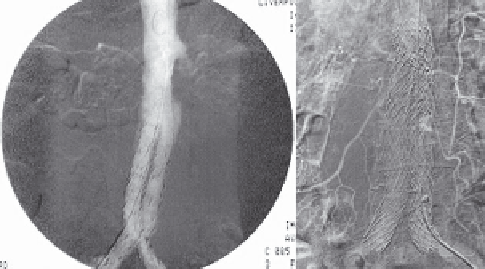Biomedical Engineering Reference
In-Depth Information
Scotland), and the Aorfi x
TM
(Lombard Medical Technologies PLC, Didcot,
UK) which have circular or helically disposed wires.
8.8
Complications of endovascular aneurysm repair
A number of complications that are specifi c to the endovascular technique
have been observed during and immediately after the operation (Chuter
et
al.
, 1998; Kalliafas
et al.
, 2000; Lee
et al.
, 2000). Manipulation of guide-wires
and catheters within diseased arteries, or the passage of large delivery
systems may result in distal embolisation of aneurysm thrombus into
femoral or visceral arteries, or thrombotic occlusion of these vessels. Dis-
section of arteries and rupture of the aneurysm have also been reported as
a consequence of intra-arterial manipulation. Inadvertent passage of guide-
wires into the heart may lead to cardiac arrhythmia and rarely even myo-
cardial rupture. Angiography at completion of EVAR has shown persistent
fl ow of blood within the aneurysm sac in a signifi cant proportion of patients
(Kalliafas
et al.
, 2000) (Fig. 8.2). This phenomenon of blood fl ow within the
aneurysm sac, but outside the stent-graft was called 'Endoleak' (White
et
al.
, 1997). Although the short- and long-term consequences of such failure
to isolate the aneurysm sac were not completely understood, it appeared
reasonable to consider it an undesirable outcome.
The incidence of such failure to isolate the aneurysm sac and the uncer-
tainty surrounding its signifi cance reinforced the need for continued radio-
logical and clinical follow-up to ascertain whether such leaks persisted or
sealed spontaneously. The need for indefi nite surveillance after endovascu-
lar repair became widely accepted.
(a)
(b)
8.2
Reperfusion of aneurysm sac via proximal attachment site (a) and
patent side-branch (b), i.e. Type I and Type II endoleaks, respectively.
Arrows point to contrast material within the aneurysm sac.



Search WWH ::

Custom Search